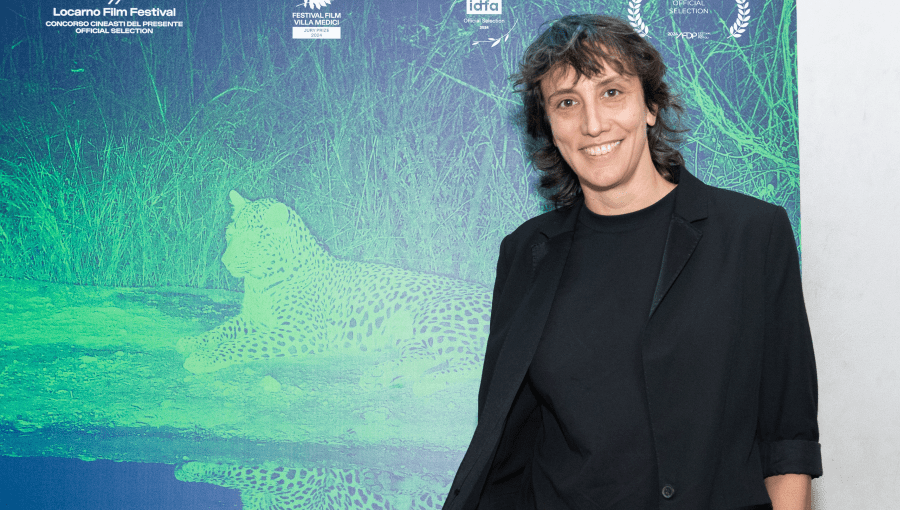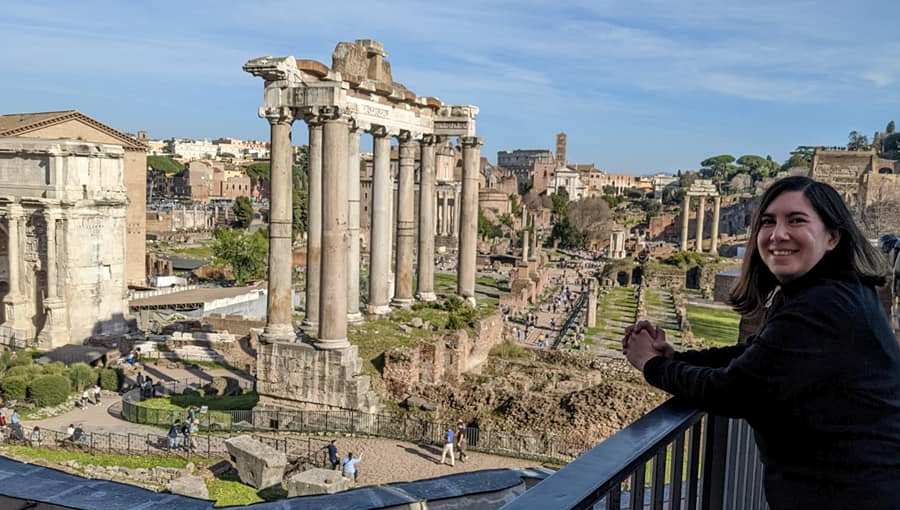Meet Professor Lila Yawn, Director of MA in Art History
Lila Yawn is Associate Professor of Art History at JCU and Director of the MA in Art History. She specializes in the history of medieval art in Italy and in perceptions of the Middle Ages today. Prof. Yawn also serves as an Arts and Humanities Advisor at the American Academy in Rome, where she was a Rome Prize Fellow (1996-1998).
What brought you to Italy and to John Cabot?
My research. After finishing most of the work for a PhD at UNC-Chapel Hill, I won a grant to spend a few months in Umbria studying illustrated Italian Giant Bibles—huge parchment manuscripts made nearly a thousand years ago. Those months were thrilling, like living in an adventure novel. I knocked on hidden doors in out-of-the-way monasteries and made friends with the monk-librarians, who let me time-travel in their virtually unknown manuscript collections. That work helped me win a two-year Rome Prize Fellowship at the American Academy in Rome. After I finished my dissertation, several universities in Rome asked me to teach for them on an adjunct basis and in 2013, JCU made me a member of the full-time faculty. I feel immensely lucky.
With so many liberal arts colleges in the US, why should one choose JCU?
Location—but not only. Does any other American liberal arts college sit next door to the Villa Farnesina (home of Raphael’s Galatea), across the street from the National Gallery of Palazzo Corsini, a few blocks from Santa Maria in Trastevere, and right along the Aurelian Wall of the 270s AD, which borders our main courtyard? The concentration of historical material and beauty right around our campus is simply without peer. With a very short, pleasant walk, you can be at St. Peter’s Basilica, the Pantheon, the Capitoline Museums, the Roman Forum, and hundreds of other lesser-known museums, palaces, churches, archaeological sites, and old, wonder-filled libraries that in any other city of the world would be the main attraction.
Location alone would not be enough, though. In the JCU Department of Art History, the professors—who, on the history side, specialize in everything from ancient Roman portraiture to catacomb painting to Baroque architecture and contemporary curating—know how to take full didactic advantage of the spectacular setting. Many of our courses meet on site. The city is their classroom. That’s true of studio art courses, too. Imagine learning to draw or to take photographs using a homemade pinhole camera in Capitoline Square.
Nearly all of us on the Art History faculty earned our academic stripes through direct research in Italian archives, excavations, and museums. We love passing along our craft—and our love for it—to our students. It pays off. Nearly all recent JCU art history graduates have gotten into the graduate programs of their choice. The list is gratifying: the Courtauld Institute, Oxford, Cambridge, University College London, Columbia University, Goldsmiths, Birkbeck. It’s thrilling to see students who only a few years ago were in our introductory classes now doing advanced work at such prestigious institutions and blossoming into brilliant researchers in their own right. Whatever stage they’re at, we continue to look after and help them however we can. They become our friends and colleagues.
Why should one still study Medieval Art History in the year 2017?
Why should one study anything else?! Okay, I’m kidding—but not entirely. Most people know very little about the Middle Ages and wheel out the word ‘medieval’ only as a synonym for ‘backward,’ ‘benighted’, or ‘ignorant’; but that’s an ignorant usage. What about the founding of the Communes (i.e. the civic governments) of Rome, Florence, Pisa, and Milan? The birth of the first universities in Europe? The building of the tallest structure on the skyline in the center of Rome today, the Torre delle Milizie? Those are all medieval achievements. Medieval Italy gave rise to astounding art and architecture, even though it is less famous and studied than, say, the Gothic cathedrals of France or of England. Think of the Leaning Tower of Pisa, the Baptistery of Florence, the mosaics of Santa Maria in Trastevere and St. Mark’s in Venice. In studying medieval art, you not only immerse yourself in enchanting beauty. (Most fairytales wear medieval clothing for good reason. So does Game of Thrones.) You also learn about a crucial thousand years of European and Mediterranean history that for most people are a void. A majority of college students come to Rome wanting to study Classical Antiquity or the Renaissance, which are certainly wonderful subjects. Medieval art is the uncommon choice, the road less traveled. And what a road!
Tell us a bit about the new Masters in Art History.
After nearly ten years of careful planning and preparation, the MA in Art History program is now up and running, and it seems unreal, in the best possible way. Our inaugural class arrived a few weeks ago: eight engaging, fascinating people, some of them recent university graduates, others returning to school from fields as diverse as microbiology, documentary filmmaking, and the culinary arts. They hold degrees from stellar universities—Mt. Holyoke, the Art Institute of Chicago, Catholic University, and other great schools—and are already hard at work on research projects that engage them directly with the primary art-historical evidence that so abounds in this astounding city.
In one course, the Practicum in Art Historical Research and Problem Solving, we are researching and writing a history of JCU’s Guarini campus and its environs from antiquity to the present. This complex, which the university rents from the Italian National Academy of Sciences, has been JCU’s home for decades. Yet its history is still a mystery. One wing, the Kushlan building, appears on the Nolli map of 1748 and in a beautiful print by Nolli’s near-contemporary Giuseppe Vasi, but exactly when the building was built, who owned it, and what it was used for are open questions. We are constructing a history from the ground up from disparate bits and pieces: maps, prints, view paintings, early photos and guidebooks, interviews, archaeological records, and interviews with people who remember the complex before JCU moved in. Last Tuesday, we spent an hour in the tower of Palazzo di Venezia studying the huge folio volumes of material assembled by the great Roman topographer Rodolfo Lanciani, author of the Forma Urbis Romae. Soon, the students will be working in the archives on their own, and at the end of the term we plan to publish our findings.
That’s just the research project for one class. Most MA students are also taking three other courses or research seminars this term—on public and private space in ancient Rome; the history of illuminated manuscripts from late antiquity to the Renaissance; the relationship between art, architecture, and social control during the Counter Reformation; or the curating of contemporary visual culture. In Spring the array will be equally varied and rich. Highlights include courses on the construction of identity in Early Christian funerary art; on Roman painting and its antecedents in the Greek world; and on erotic art during the Renaissance.
Tell us about your “Culiseo” article.
Imagine going up in a hot-air balloon and looking down on the Colosseum. Does it remind you of anything? Think body parts. Need another hint? Okay: orifices. I am channeling here for humorists of the 1400s and 1500s—Burchiello, Pietro Aretino, Benvenuto Cellini–who cracked jokes right and left about the ‘Culiseo’: the Colosseum as a big derrière or anus (culo). The general public, I think, tends to imagine Italian Renaissance writers and artists as fairly straight laced, but there was an incredibly bawdy side to Renaissance culture. The writers who made culiseo jokes were lampooning Rome and the Romans. (The jokesters were nearly all Tuscans.) But they were also poking fun at the extravagant descriptions of the Colosseum in medieval and early Renaissance guidebooks. By the 1100s, people seem to have forgotten the Colosseum’s original use for blood sports, imagining instead that it had been a mega-temple erected by the ‘magician’ Vergil, or that it had once contained a mirror in which one could see everything in the world—imaginative projections onto the past that suited one of the chief symbols of Roma caput mundi, Rome as head of the world. ‘Culiseo’ jokes satirized these flights of fancy by turning the ‘caput’ into a ‘culus.’ To get the full thrust of the humor, it’s also essential to know about one the Colosseum’s main functions in the Renaissance. It was where people went to find and enjoy illicit sex, especially of the ‘sodomitic’ variety.
Are there any other projects you are working on you would like to share? What are your future projects?
At the moment, I’m struggling to finish an article about the impact of the Codex Amiatinus, the earliest surviving complete copy of the Latin Vulgate Bible. It’s a massive illustrated manuscript made around the year 700 in the far north of England, which came to Italy as a gift for the pope but ended up at a monastery in southern Tuscany. I’m looking at how it inspired local Italian scribes and artists, especially in the 11th century, when it first shows up on the historical radar in Italy.
Some Italian colleagues and I are also working to publish a volume of collected studies on Anacletus II, the so-called ‘Jewish Pope.’ Anacletus belonged to the Pierleoni family, from Trastevere (our neighborhood), which only a few generations before his time had converted from Judaism to Christianity. That heritage did not prevent him from becoming a highly respected churchman. He had the misfortune, however, of being elected pope on the same day as another cardinal—this happened in 1130—and ultimately ‘lost’ the schism, partly by dying before his rival did. The Catholic Church today considers him an ‘antipope.’
There are also a few conferences around the bend that I have a hand in: ‘The Middle Ages in the Modern World’ in November 2018; and the second meeting of a group of textual scholars, art historians, archaeologists, and scientists (palynologists, geologists), who are working together to study how landscapes and climates changed in medieval Italy. Once those events are over, I look forward, first to a good vacation, and then to diving into a project that’s been on my back burner for years now: a book on the Colosseum from the Middle Ages to now–‘culiseo’ puns and more.
What is your teaching philosophy?
My philosophy is outlined in a text that goes on all my course syllabi. I owe it to one of my heroes, Fr. Leonard Boyle, long-time prefect of the Vatican Library and a very great scholar of the Middle Ages: “The twelfth-century philosopher and theologian Hugh of St. Victor summed up our learning ideal: ’Omnia disce. Videbis postea nihil esse superfluum. Coartata scientia iucunda non est.’ Learn everything. Afterward you will see that nothing is superfluous. Knowledge narrowed down is not a joyful thing (De historia, et libris in ea legendis, Book VI, chapter 3). The goal implicit in Hugh’s dictum lies not in knowing absolutely everything, which is impossible, but rather in unleashing the insatiable curiosity and inquisitiveness that lead to exhilarating, bountiful, and often unexpected learning.”
Is there anything else you’d like to add?
I highly recommend going to see William Kentridge’s Triumphs & Laments on the Tiber embankments between Ponte Sisto and Ponte Mazzini, near the JCU campuses. It’s the greatest work of public contemporary art in Rome and was made by selectively washing away the black gunk that grows naturally on the travertine. Triumphs & Laments is closely tied to the JCU Department of Art History and Studio Art. My students and I furnished Kentridge—one of the most sought-after artists at work today–with his iconographic palette and wrote a bilingual guide to the imagery. It was a dream project for us, but it won’t be there long. The images are deliberately ephemeral and will disappear naturally in another year or two.






